Old West Mason Jars
Old West Mason Jars
.

A blue Mason Patent Bottle dated 1858. Image: laureleaffarm.com via Pinterest.
.
Victorian-era Patents: Mason Bottles
.
.
1858 Glass Jar Patented by John L. Mason, hence the familiar term “Mason Jar.”
.
.
Improvement in Fruit Jars
.

J.L. Mason Fruit Jars. Patent for Fruit Jar improvements, May 10, 1870.
.
While John L. Mason’s patent for the bottle blower was renewed in 1876, he apparently did not renew the patent for the canning jar. An article published by thinkprogress.org (2014) states Mason’s patent expired in 1879. This article continues, stating, “Canning continues to grow in popularity, but what smarts Mason has in innovation he lacks in business sense. He loses many of his patent rights to competitors and dies, penniless, in New York in 1902.”
.
Other Brands of Canning Bottles
.
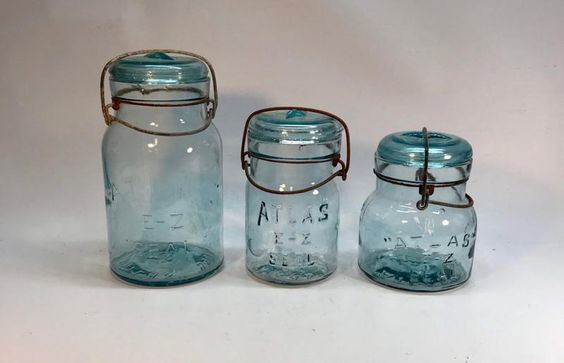
Three antique Atlas canning jars in graduated sizes. Image: antiques.LovetoKnow.com via Pinterest.
.
Mason wasn’t the only brand. Nor was John L. Mason’s 1858 patent the only design on the market. Mason had competition from the Ball brothers, Kerr, and Atlas Jars. Some canning bottles had clamps (with rubber seals; you’ve probably seen remakes for use in home decor).
.

Two Ball Masons, one clear and one blue. Ball Co. logo dates to 1900-1910. Image: Pinterest.
.
The Ball Brothers Glass Manufacturing Co. started operations in Buffalo, New York in 1884.
.
Advertised Fruit Jars and Jelly Tumblers
.
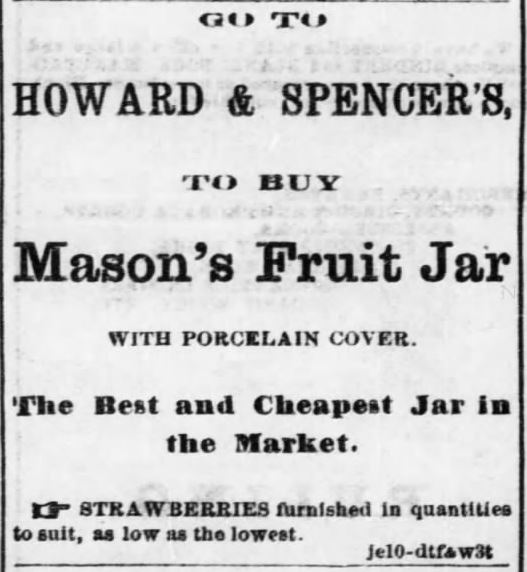
Mason’s Fruit Jar with Porcelain Cover advertised by Howard & Spencer’s in The Daily Kansas Tribune of Lawrence, Kansas, July 12, 1870.
.

Illustrated advertisement for “Cheap, Simple, Reliable Fruit Jars, All Glass… Lids and Clamps in One Piece. Cohansey Glass Manufacturing Company of Philadelphia. Advertised in The True Northerner of Paw Paw, Michigan, May 4, 1877.
.
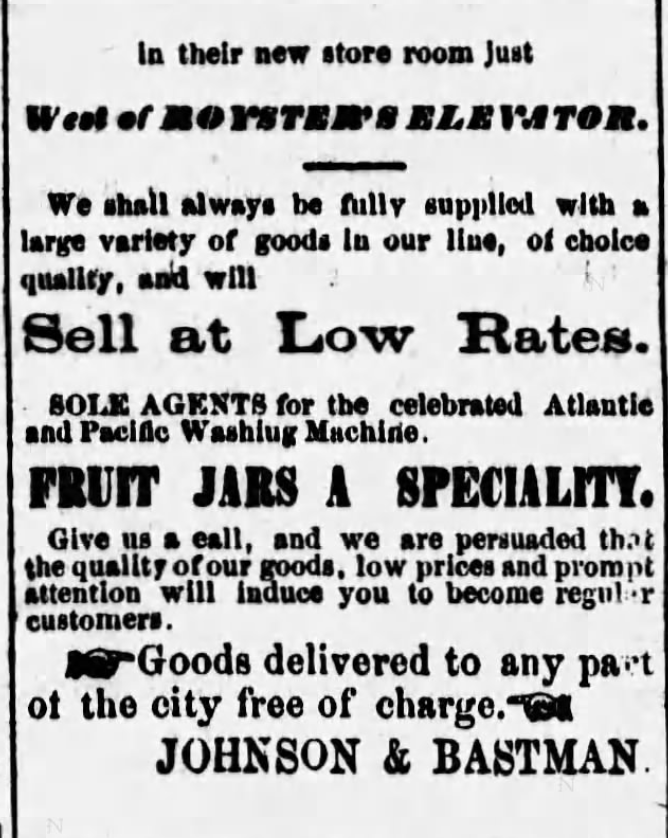
Ad for Fruit Jars sold at Johnson & Bastman, published in Chanute Weekly Times of Chanute, Kansas on October 11, 1877.
.

Mason Fruit Jars for sale, advertised in the Oakland Tribune of Oakland, California on July 26, 1894.
.

Queen Squat Jelly Tumbler with Glass Lid. 1895 Montgomery, Ward & Co. Catalogue.
.
Note the final item listed (Queen Squat Jelly Tumbler, with glass cover). Used in “putting up” jelly, it has a glass lid, “more desirable than” a tin cover. One dozen of the strong, heavy glass jelly tumblers with glass lid sold for $0.64 in 1895, approximately $18.82 in today’s dollar.
.
$0.64 of 1895 dollars would be worth: $18.82 in 2019 (latest year available). [source: Dave Manuel.com Inflation Calculator]
.
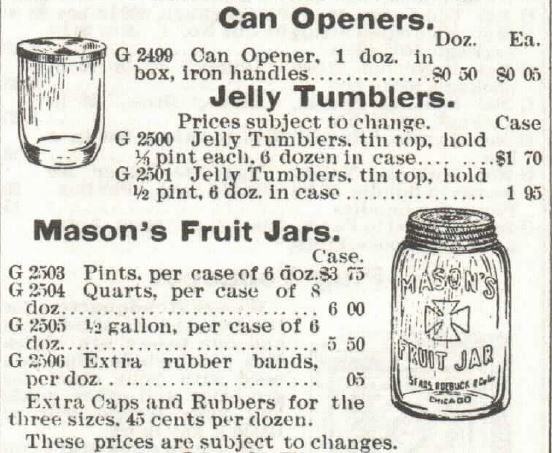
Jelly Tumblers and Mason Fruit Jars offered for sale in the 1897 Sears, Roebuck & Co. Catalog, No. 104.
.
Six dozen glass Jelly Tumblers with a tin top, sold for $1.95 back in 1897.
.
$1.95 of 1897 dollars would be worth: $59.09 in 2019 (latest year available). [source: Dave Manuel.com Inflation Calculator]
.

Jelly Tumbler and Mason’s Fruit Jars from the Sears, Roebuck & Co. Catalogue, 1898.
.

Montgomery, Ward & Co. Catalogue, 1895 offers Mason Jars with porcelain lined caps and Globe Jars with glass top. See the tin-top jelly tumblers listed last.
.

Fruit Jar Rubbers (rubber rings) offered for sale in Montgomery, Ward & Co. 1895 Catalogue.
.
19th Century Kitchen Tools for Bottling
.

Jelly Funnels offered by Sears, Roebuck & Co. Catalogue, 1898.
.
Canning funnels really haven’t changed. They may have been made from seamless tin back in the late 19th century, and now they’re available in plastic or metal, the design is either for standard or wide-mouth jars.
.
.

Fruit Jar Holder, a patent item sold by Montgomery, Ward & Co. Catalogue, 1895.
.

Ideal Fruit Jar Wrench sold by Sears, Roebuck & Co. Catalogue, 1898.
.
.
Canning Season
.

Two interesting methods of washing glass bottles and jars. From The Boston Globe of Boston, Massachusetts, October 26, 1896.
.
Nineteenth-century homemakers would begin “putting up” garden vegetables from the very first showing of spring peas and continue on clear through the hard frost that signaled the end of the growing season. As different fruits and vegetables bear at different times, with some overlap, it’s a never-ending chore. But if they wanted vegetables and fruit to sustain them through the winter, the job had to be done. Yes, some root vegetables would last pretty well in a root cellar (unless they froze), but only as long as they lasted.
A diet consisting only of meat (a significant source of nutrition in winter months), potatoes, carrots, parsnips, and winter squash could get really old. I’m sure a bottle of Mother’s peaches for a dessert cobbler or a dish of applesauce with the Christmas ham made all the difference.
.

.
I know from personal experience what a hot, sticky, exhausting job (but very rewarding) home canning is. And I had the luxury of running water, a gas range, air conditioning, and the like. I can’t imagine (or perhaps I can, though I don’t want to) what it would be like canning off-and-on for four or five months each year over a wood-burning (perhaps coal) stove. Some Nineteenth Century homemakers had the luxury of a gasoline stove (picture a Camp Chef camping stove with a propane tank, Victorian style) or a “summer kitchen” allowing them to do the work away from the family’s main dwelling as to not heat the house unnecessarily. Others simply “put up and shut up”.
.
Preservaline: The Great Food Preservative
.

Advertisement for Preservaline, a food preservative. Sold in Sears, Roebuck & Co. Catalogue, 1898.

Cider and Fruit Preservaline (preservative). Sold by Sears, Roebuck & Co. Catalogue, 1898.
.
Preservaline shouts “harmless to health!” And “not an adulterant!”
They say it keeps food fresh without need for ice or cooking. Claims to keep milk and cream sweet. And meat in sound and perfect condition without affecting the flavor, taste or nutritive qualities.
100+ years ago, disclosure of contents wasn’t law. It’s no surprise these ads don’t give away the contents.
Preservaline was none other than formaldehyde.
.
.
Old West Mason Jars Today
.
.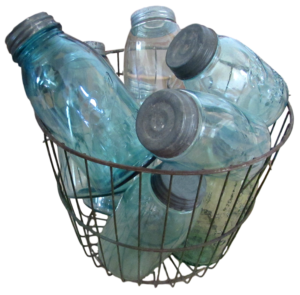
.
Home industry has become popular (again), as has prepping. People grow more gardens and fruit trees and organic foods to combat an ever-growing list of food pesticides and allergies. Yes, this means more home bottling.
Pretty jars lined up on canning day give a person a tremendous sense of satisfaction. A job well done!
.
Related Articles
.
.
 Â
.
Updated August 2021
Copyright © 2016 Kristin Holt LC
Old West Mason Jars




























Great post. I’ve done the canning thing. So happy I can buy what I need at the store.
So true, isn’t it Robyn? I’m grateful stores everywhere (brick & mortar as well as online) sell canning supplies… or canned peaches for those seasons I simply don’t get to home bottling the fresh peaches grown in orchards near home. Thanks for stopping by!